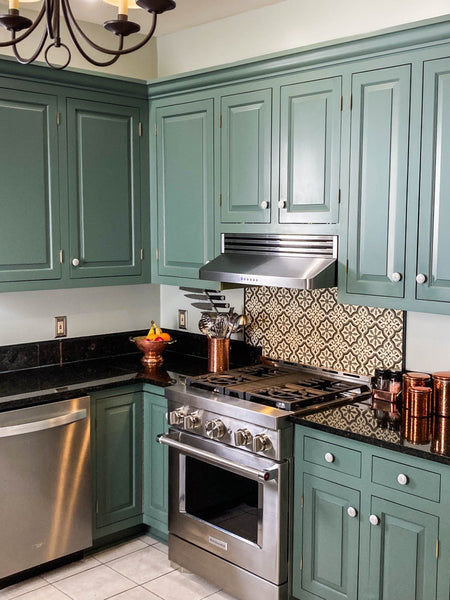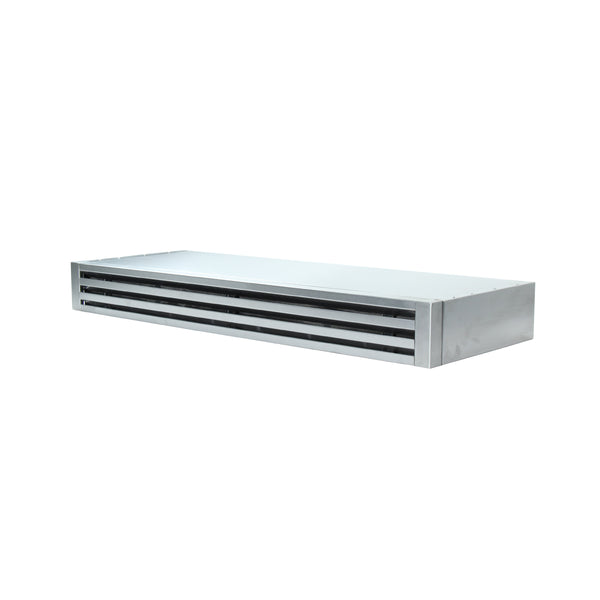You walk into your kitchen one day and notice cold air coming down the range hood vent and into your kitchen. What could be the cause?
Fortunately, this is an easy problem to solve.
If cold air is coming down your range hood vent, install a backdraft damper. A spring-loaded damper is the most reliable. If you already have a backdraft damper, check if it is bent or damaged. Also, make sure that the damper is grease and grime-free. It should open and close smoothly.
Option 1 - Install a backdraft damper.
There are two places you can install your backdraft damper.
A damper a few feet away from your vent cap will keep debris and small animals out of the duct. If you are worried about backdrafting, install the damper a few feet away from the top of the hood where it connects to the duct.
Typically a range hood should have one backdraft damper. Some hoods have two dampers: one near where the duct connects to the hood, and one at the other end of the ductwork. But two dampers are not necessary in most cases.
A spring-loaded damper is more reliable at keeping cold air out than a standard damper without a spring. Thanks to the spring mechanism, it can’t be pushed open by harsh winds or small animals.
Here is an example of one with a spring and one without a spring.
If in doubt, contact the manufacturer of your range hood to see which damper is best for you.
If you already have a backdraft damper, here’s what you can do.
Option 2 - Check if it is bent or damaged.
Go outside or in your attic to inspect the damper. See if it is bent or damaged. Some wear and tear may be normal. But if your damper does not open and close properly, you may need a replacement.
If you’re outside, check on the wall or roof cap too. Make sure that it is in good condition and secured to your duct. If you notice any cracks or the threads on the cap are worn, buy a replacement.
Option 3 - Make sure it is clean.
If you see any heavy grease buildup, grab a kitchen degreaser and a towel and clean your damper. Heavy grease may prevent the damper from opening and closing properly, allowing cold air to sneak in your duct.
Detach the damper from the duct to make cleaning easier.
While you’ve got your degreaser handy, clean your range hood filters. If your filters are not cleaned often, the damper will keep getting clogged and grimy.
Option 4 - Make sure any duct screws don’t interfere with the damper.
Depending on your duct installation, you might have secured the duct with screws at different points. These can prevent the damper from opening, letting cold air in. Tighten them so they are flush with your duct. Or carefully adjust the damper, if possible, so it’s away from the duct screws.
If that doesn’t work, remove the screws and install them in a different spot away from the backdraft damper.
If you hired a contractor to install the duct, it’s possible they placed the screws incorrectly. Give them a call and they can help resolve the issue.
After dealing with the screws, check that the damper opens and closes properly.
How do you insulate hood vents?
This involves four main steps:
- Seal any gaps in your duct with foil tape.
- Use a duct sealant to seal any gaps in the elbows.
- Cut and wrap insulation around your duct.
- Secure the insulation in place with foil tape.
For more information, check out our article ‘Should a vent hood duct be insulated?’
How do I permanently close off a downdraft vent?
Buy a wall or roof cap and secure it to the vent outlet with caulking glue. You can also spray the inside of your duct with spray foam. But the foam doesn’t always create an airtight seal, so you’ll want to cap the duct anyway. Not to mention that different brands of spray foam may work better than others.
Is a range hood damper necessary?
Yes, a range hood damper keeps cold air from entering your range hood vent. This saves you some money on heating your home. It also prevents debris and small animals from entering the duct so you don’t have to clean it out.
What does a damper do on a range hood?
A backdraft damper prevents small debris or animals from entering your range hood duct. It also keeps cold outside air from coming through the duct into your kitchen.
Related: How can range hood inserts improve your kitchen design?
Where is the damper on a range hood?
A range hood damper is inside the ductwork. It’s often found near the exterior wall or roof where the duct terminates. Some dampers are installed near the top of the range hood.
Can you duct tape a range hood?
When sealing a range hood vent, use aluminum tape rather than duct tape. It adheres much better to metal ductwork.
Hopefully you found this article on range hood ducts helpful. Consider installing a backdraft damper if you feel cold air coming into your kitchen from your hood.
If you feel cold air coming in even with a damper, inspect it for damage. To keep cold air out, it has to open and close smoothly.
Thanks for reading!
Related Articles
Do I need a damper for my range hood?
What is backdrafting and how does it apply to range hoods?











